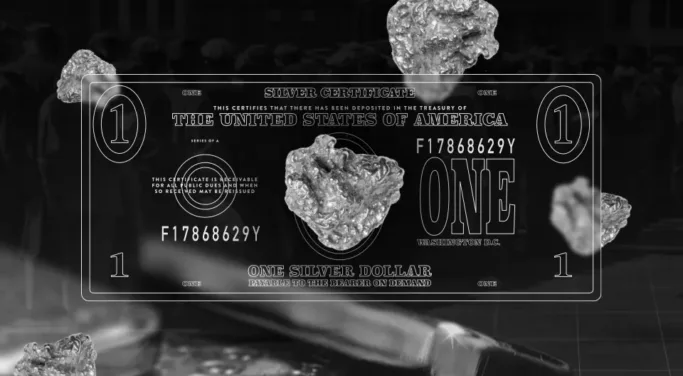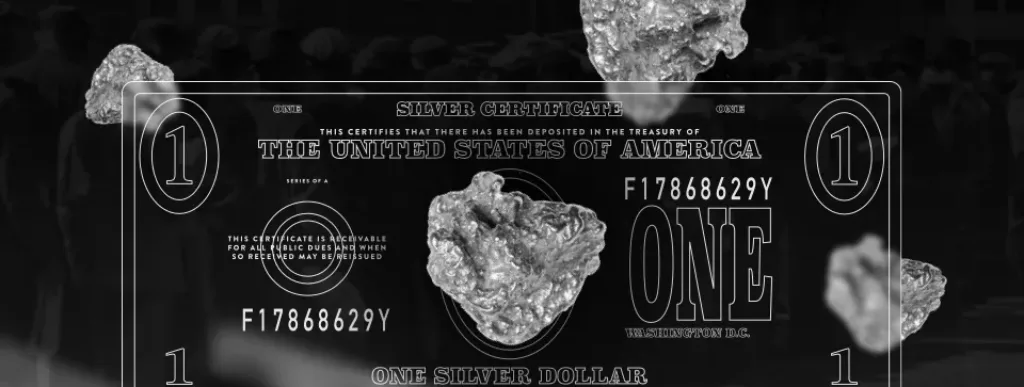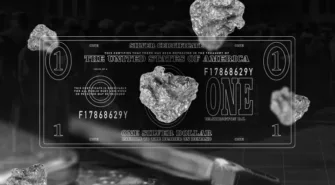A silver certificate is a paper document certifying you own the amount of silver mentioned on the certificate.
This gives you the flexibility to use the certificate as a form of payment. In other words, you don’t have to carry around the physical silver itself.
The United States issued the most widely known and traded silver certificates. Silver-certificate dollar bills, issued between 1878 and March 1964, bore many of the same features you see on $1 bills today. Other countries, including Cuba and the Netherlands, created them too, as well as mints and bullion producers around the world.
The History of Silver Certificates
Silver certificates date back to the 19th century and came about following two key U.S. congressional Acts.
Until the Coinage Act of 1873 was passed, miners could present their metal to the Mint and have it struck into coins. The Act did away with this, essentially signalling the end of the Silver Standard and effectively placing the U.S. onto the Gold Standard.
This was the end of the era of bimetallism. Until then, both gold and silver were legal tender. The government and its authorised agencies could mint new coins in unlimited quantities in either gold or silver.
When the shift to the Gold Standard occurred, demand for silver dropped sharply, causing the price to plummet.
The Coinage Act helped birth the “free silver” movement. The movement’s supporters, known as “Silverites”, lobbied hard to keep silver’s place in the U.S. monetary system.
They succeeded with the Bland-Allison Act of 1878. The law compelled the US Treasury to buy $2 million to $4 million of silver each month from mining companies.
They could then convert their silver into coins so, once again, silver became a form of money.
A Medium of Exchange
This change in monetary policy also brought about the creation of silver certificates.
These certificates made it much easier to use silver as a means of exchange. Silver is heavy and carrying a lot of it around was impractical. Because gold is much denser than silver, you don’t have to carry so much around.
This was one of the main reasons that gold as a form of money grew in popularity.
Each certificate carried the words “One dollar in silver is payable to the bearer on demand”. For every silver dollar issued, there was an equivalent amount of silver held by the U.S. Treasury.
The first series of silver certificates ran from 1878 to 1923 and were much larger than today’s paper money.
Silver-certificate dollars were available in the following denominations – $1, $2, $5, $10, $20, $50, $100, and $1,000.
By 1928, the bills themselves became smaller. They were now only printed in denominations of $1, $5 and $10 until the U.S. Treasury eventually discontinued them in 1964.
For the next few years, the certificates were still redeemable for physical silver. On the 24th of June 1968, all redemption ceased.
The certificates remain legal tender today worth the value stated on them. However, the collector value now often outweighs the value shown on the note.
The U.S. were also prolific issuers of gold certificates during this time.
In the Netherlands, a shortage of silver for minting saw the Dutch government introduce silver certificates in 1914. They used these certificates right up until 1938. Cuba issued their own silver certificates between 1934 and 1949.
Understanding Silver Certificates
Silver certificates were the forerunners to paper fiat money used today.
Instead of paying for goods and services by silver, the certificates acted in place of the precious metal. There was silver in the U.S. Treasury backing up the value of every silver-backed bill in circulation.
This one-for-one exchange mechanism was a cornerstone of monetary policy from the late 19th century. This continued right up until the U.S. stopped producing the certificates in the 1960s.
Paper currency is the predominant form of valid legal tender today. What makes them different is that, unlike silver dollars, there is no commodity backing this money at the U.S. Treasury.
It’s no longer the amount of gold or silver that controls the level of money in circulation – it’s the central banks and governments.
The Value of Silver Certificates Today
What determines the value of silver certificates today are their rarity and their condition. The US issued certificates for over 80 years with a large variety of designs throughout those print runs.
Those dating back to the first issuances from the late 1870s and 1880s are rarer. They’re also typically the most valuable as a result.
The crisper the note, the more valuable it is. Those with no blemishes or folds and in perfect mint condition are more likely to attract the highest value.
Other elements that will boost appeal among collectors are lower serial numbers or an unusual design.
For example, certificates typically only carried the image of famous US men. Martha Washington was the only woman to appear on a US silver certificate. She first featured on certificates in 1886 and those notes are highly collectable.
Find out more about Kinesis’s KAG silver-backed digital token and the current price of silver.
This publication is for informational purposes only and is not intended to be a solicitation, offering or recommendation of any security, commodity, derivative, investment management service or advisory service and is not commodity trading advice. This publication does not intend to provide investment, tax or legal advice on either a general or specific basis.




